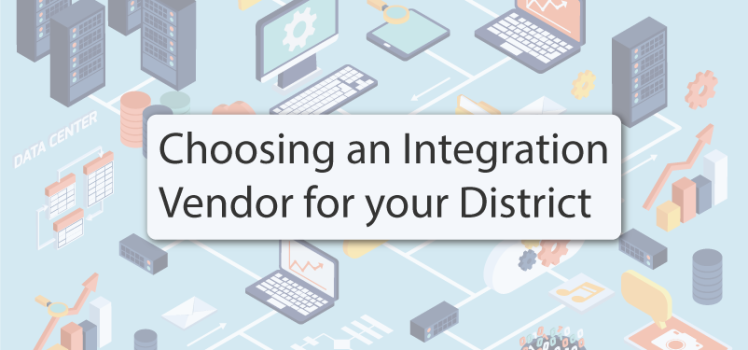15 Questions to Ask When Choosing Your Data Integration Vendor

It isn’t easy to choose a vendor when deciding on how to integrate your data and applications in your district. With so many vendors out there offering solutions, how do you pick the right vendor? How can you be certain you are buying a system that is sustainable both now and in the future? To help you choose for your district, we have put together some helpful questions to ask vendors about their integration solution.
1. How many industries does your company sell solutions to?
With so many industries out there – from health care to enterprise businesses, it is tough to weed through what everyone has to offer. Ask your vendor is they specialize in education and how many clients they have in the education world. Education is unique among other industries and has some very specific challenges that vendors not used to education might not understand.
Education has more users than many vendors are used to dealing with. From students to teachers to parents to support staff and administrators, the education world has broad user base. These users are also highly mobile, moving from computer to computer, room to room, and school to school. In nearly every other industry, users have their own computers that they go to every day. In education, every piece of equipment is shared. Vendors not used to education may treat your district like a large office building and have difficulty managing the struggles and mobility of your users.
2. Do you have a strong understanding of FERPA and HIPPA?
Security is another major issue that vendors not familiar with education may struggle with. Access to data and apps must be secured due to the legalities of FERPA, HIPPA, and district policies. The personally identifiable information of a student is sensitive data and must be protected for the safety of the students. Vendors with no experience in FERPA or HIPPA legislation might not understand the severity of a data breach surrounding student data.
3. Can I upkeep your solution on my limited number of staff members?
The vendor you choose needs to understand that your district’s IT staff is comprised of about 10% of what a corporate IT staff contains. This means that you need to implement something simple, robust, and easy to sustain. Hiring contractors to maintain the system is not usually an option, and hiring more IT staff is rarely an option for a school district. Lastly, the vendor needs to understand that you are a public entity that does not sit on infinite funding. Therefore, costs need to be reasonable. A seasoned education contractor understands these limitations.
4. How long have you been in business? How long have you been in the PK-12 business? Why are you pursuing the PK-12 business?
There is so many vendors out there offering solutions for education today, and if it seems like the number grows daily, you are right. New startups are doing some great things out there, but you need to understand if they have the experience needed to work for your district. Ask your vendor how long they have been in business. Take a look at their owners and investors to see how much experience they truly have in education. Do they have founders that have real life education experience?
As more money in the form of grants are offered to education, investors see opportunity in education and work with new startups to create new software. These investors can pump millions of dollars into new startups. The issue with some of these startups is that they lack in the understanding of education and the specific challenges of education. Ask the vendor why they chose to do business with education. Selecting a vendor that has true focus on education will give your district the peace of mind that your vendor will understand the challenges of your district better.
5. Do you charge for integration consulting? What kind of consulting can I get before I agree to a purchase?
There are many companies that charge for everything, and we mean everything! When speaking to vendors, make sure that they are willing to help you with some consulting at no charge prior to making decisions. They should be able to give you choices, implementation considerations, and a light amount of consulting services prior to the PO. Also ask about change orders once the project starts. Is everything chargeable? What is the change process? Are there any changes that can be implemented at no cost? Most education data integration projects must remain agile because there are so many unknowns. Your vendor needs to understand that there will always be a certain amount of changes that occur as discovery takes place. Make sure that you don’t have to pay for everything.
6. Does your software meet my integration needs and not just a great dashboard?
You need to make sure that you are purchasing software or a solution that meets your needs. Think about the back end as well as the front end. In other words, if the dashboard looks great, but it is going to be impossible or very difficult to maintain the data for the dashboards, you might want to look elsewhere. On the other hand, if the back end is awesome, but the dashboards are not what your teachers are looking for, you might want to consider splitting your purchase into two sections. There are virtually no companies that can provide you with the data integration infrastructure that is easy to maintain and automated AND provide you with awesome dashboards that your teachers love. Consider looking for an infrastructure company that can make your life easier with respect to data integration and then look for another company that can provide you with dashboards that will run on any database server you have chosen. The two audiences are different and you need to purchase something that makes sense for both stakeholder categories.
7. How flexible is the software configuration? Can I make changes to the configuration myself? How do we add data, users, and applications to the system after the initial implementation? What happens if we change our Student Information System?
The software should be flexible enough to allow you to integrate all or nearly all of your systems. You should be able to make configuration changes yourself without incurring heavy consulting service fees. You should be able to add data to the system yourself, and not have to rely on the vendor to do that work for you. You should be able to add applications to the system without incurring expensive consulting fees. Most important of all, your system should be able to sustain itself when the SIS or other software changes. If you have to rebuild every time requirements change or applications or modified, then you need to look elsewhere. Flexibility allows your system to stay up-to-date and remain sustainable.
8. Do you offer training so that I can maintain the system myself?
You need to get training on the system you purchase. Whether you maintain it yourself, or hire the vendor to maintain it, you need to understand how it works. If the training is too extensive, or non-existent, you might want to consider another solution.
9. What are the system’s hardware requirements? Does it sit in the cloud? How expensive is the cloud-hosting?
There are 2 options for software systems today. The first is to host the system at your district location and the second is to have the system located in the cloud. If you plan on hosting the system, you need to understand the hardware requirements that provide the optimum performance for your district’s use. If you plan on using a cloud-based system, how does that raise your cost? Some cloud-based systems are very expensive. You might want to explore a compromise – have the vendor host the system at your location with your hardware. That way, they take care of the system but you do not have to pay the cloud access charges.
10. If the system is cloud hosted, where will your data be physically located? How secure is your cloud?
Be aware of the terms and locations of where your data is located. Ask if the data is hosted in the United States or overseas. Read the fine print of the hosting to be sure that they cannot sell the data to other companies or use the data for other purposes. Your data needs to be stored in the United States and should never be sold or used for other purposes by the vendor. Also be sure to ask the vendor about their cloud security practices.
11. Is the system scalable? How hard is it to add more horsepower to the system?
You should ask questions about how to expand the system if you need more horsepower. Is the software scalable? How hard is it to add more hardware? What are the configuration issues when adding more hardware? Many times, systems are great in the beginning. Then, more data is added. More users are added. The system performance becomes poor. Ask questions and make sure that updating system performance will not be overly difficult or expensive.
12. How long will the implementation take and what will be my responsibilities?
You should understand completely how long an implementation will take. Will it be ready in 6 months? A year? More than a year? You also need to understand how much time you need to spend on the implementation so that you have reasonable expectations. If the vendor expects you to spend 20 hours a week during the implementation, but you only have 10 hours a week to spare, how will that affect the timeline? Also, you need to make sure that you have the expertise to help where it is needed. In a database system, there are usually many people that work on a system. You need to make sure that you have everyone’s cooperation when undertaking a data integration implementation. If you need data from Application X, but that data owner won’t agree, you have a problem. Make sure you have buy-in from all your data owners before beginning a project. Delays caused by your organization will most likely raise the cost of the implementation. Be sure to understand the implementation process before you get started. It will save you time and money.
13. How do you handle support after the implementation?
All systems require support from the vendor. Ask about how much support costs and what are the support options. What are the hours of support? What will the vendor provide for the support option requested? If you feel you need more support than what is offered, ask the vendor if they can provide you with packages of consulting/services hours that are less expensive if purchased in advance. Your vendor should be flexible in the support area. Also, call references to ask about the vendor support provided. Does the vendor call back in a timely fashion? Do they seem interested in your issues? Does the vendor make every effort to solve your problem as quickly as possible? A data integration solution is a long term solution, and you need to be able to trust your support structure.
14. Does your vendor offer ways to collect and validate the data in real time? Is the data stored using data standards or is it a proprietary model?
Data integration is not just about data collection once or twice a day. Data needs to be able to move around in real-time using events so that data never gets stale and outdated. Ask your vendor if they only provide ways to collect data using batch files or do they offer real time data collection. Get a detailed description of how your data will be stored and what format it will be stored in.
15. How can you use your own data once it is collected?
Some data integration vendors don’t give you true access to your own data once it has been collected. This is especially important with hosted solutions. Ask your vendor if you can access you data via an API or other methodology. Ask if there are fees associated with retrieving your own data. If there are fees, find out upfront how the fees are structured and how often you pay them.
We know there are lots of other questions to ask about technical details, but these 15 questions work as a great starting point when you are shopping for a data integration solution.
If you would like to learn more about how CPSI helps districts with data integration or would like to learn more about our products, please visit our website. You can also call us at 800-689-8240 or e-mail us at [email protected].




